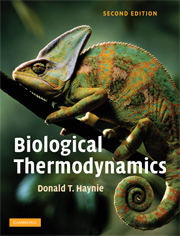Book contents
- Frontmatter
- Contents
- Preface to the second edition
- Chapter 1 Energy transformation
- Chapter 2 The First Law of Thermodynamics
- Chapter 3 The Second Law of Thermodynamics
- Chapter 4 Gibbs free energy – theory
- Chapter 5 Gibbs free energy – applications
- Chapter 6 Statistical thermodynamics
- Chapter 7 Binding equilibria
- Chapter 8 Reaction kinetics
- Chapter 9 The frontier of biological thermodynamics
- Appendices
- Glossary
- Index of names
- Subject index
- References
Chapter 7 - Binding equilibria
Published online by Cambridge University Press: 05 June 2012
- Frontmatter
- Contents
- Preface to the second edition
- Chapter 1 Energy transformation
- Chapter 2 The First Law of Thermodynamics
- Chapter 3 The Second Law of Thermodynamics
- Chapter 4 Gibbs free energy – theory
- Chapter 5 Gibbs free energy – applications
- Chapter 6 Statistical thermodynamics
- Chapter 7 Binding equilibria
- Chapter 8 Reaction kinetics
- Chapter 9 The frontier of biological thermodynamics
- Appendices
- Glossary
- Index of names
- Subject index
- References
Summary
Introduction
We have seen how the First and Second Laws are combined in a thermodynamic potential function called the Gibbs free energy. We have also seen how the Gibbs energy can be used to predict the direction of spontaneous change in a wide variety of systems under the constraints of constant temperature and pressure. One type of application of the Gibbs energy, which we studied in Chapter 5, is the binding of a ligand to a macromolecule. And in Chapter 6 we became introduced to statistical thermodynamics, a mathematical formalism that permits a molecular interpretation of thermodynamic quantities. The present chapter combines and extends all these ideas. Binding is a ubiquitous and immensely important general topic in biochemistry. While binding can be considered just one of many different types of equilibrium process, the key role it plays in the physiology of biological macromolecules makes the present chapter one of the most important of the book.
Let's do a brief survey of areas in biology where binding plays a role – before plunging into a sea of mathematical equations. In our discussion of the First Law (Chapter 2) we encountered RNase A, a digestive enzyme that can bind tightly to a nucleotide inhibitor. Then in Chapter 5, we looked at receptor–ligand interactions and an introductory analysis of oxygen binding to hemoglobin. And an exercise in Chapter 5 involved the binding of a regulatory protein to DNA (Fig. 7.1).
- Type
- Chapter
- Information
- Biological Thermodynamics , pp. 250 - 280Publisher: Cambridge University PressPrint publication year: 2008



